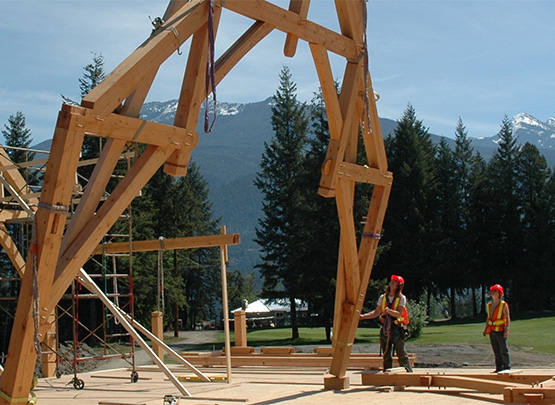
There are many things to consider when designing your timber frame home. In addition to the house’s style and the type of wood you’d like to use, timber frame construction gives you the option of using green timber framing or having the timber kiln dried. But what’s the difference, and which one should you choose for your new home? In this article, we’ll talk about building with green lumber versus kiln-dried timber, including the advantages and disadvantages of both methods. We’ll also explain how air-dried timber differs from kiln-dried wood.
Whether you’re investigating green oak timber frame construction or looking for a custom timber frame kit using Douglas fir, Hamill Creek Timber Homes can help you build your dream home.
What is Green Wood?
Green wood — or green timber — is a timber that has been cut from the forest and immediately used for timber frame construction, without seasoning or drying. When wood is “seasoned,” it is left to dry for a long time so that the moisture evaporates. For those building a timber frame home, you can choose from green timber, seasoned timber (air-dried) or kiln-dried timber.
Can You Build with Fresh Cut Lumber?
Building with green lumber for timber frame construction can save time, money and energy. With green timber, you can begin building right away without having to wait for the wood to dry, or having the added cost for kiln drying, which uses environmentally damaging fossil fuels during the drying process. However, fresh timber will shrink as it dries.
While it’s possible to use special construction methods to work around this issue, Hamill Creek Timber Homes uses both air drying and kiln drying to reduce the moisture content of the timber for a more stable, long-lasting product. We have the expertise to know the type of preparation needed for every part of your new timber home, for both exterior and interior framing.
Should You Air Dry or Kiln Dry?
There are advantages and disadvantages to both air drying and kiln drying methods. Whatever type of wood you use, the timber in timber frames should have on average 19% or less moisture content. This is very important since properly dried timber will minimize the effects due to shrinkage and expansion throughout seasonal changes.
Air Dried Timber – The primary advantage of air drying timber is that it’s less expensive than kiln drying. For environmentally-conscious homeowners, air-dried timber does not use any fossil fuels to dry. The main disadvantage of air drying timber is the time it takes. Air drying wood is a slow process—approximately .5-1 inch per year, depending on the type of wood. For natural drying, oversized timbers are stacked and separated by dividers, which allows for even, thorough drying. When the drying is done, they’re planed to the proper size, removing any twisting and splits.
Kiln Dried Timber – Kiln dried timber’s main advantage is that it’s faster than air drying. However, it’s a more expensive process, stresses the wood more than air drying and uses fossil fuels to produce the heat that’s needed to dry the wood. Kiln drying timbers is typically done with radio frequency (RF) and, like air drying, bring the moisture of the wood down to 19% or less. One important aspect of kiln-dried timber is that 2-inch lumber or thinner is more efficiently dried in kilns that larger timbers. Therefore, most timber drying in kilns is for smaller timber thicknesses or dimensions. These thinner woods are used for flooring or for trims, where it is more important to have a moisture content below 12%.
What is the Basic Process for Kiln Dried Timber?
For kiln drying of timber, electromagnetic waves at the radio frequency (RF) range, like those produced by a cell phone, are introduced. An amplifier is used to generate a fixed frequency so that the heat can be controlled, keeping the wood at a consistent temperature.
Upon exposure to RF, the water molecules in the wood are excited so that they align and then exit the wood through its natural veins. This is the same way, in reverse, that water entered the tree during its growth.
Choose Hamill Creek for the Best Timber Frame Home Construction
Hamill Creek Timber Homes is the premier source for expert advice and construction of exquisite timber frame homes. Located in British Columbia, we have access to some of the finest timber in the world, sourced directly from sustainable forests. We have been timber framing since 1989. Contact us today to discuss your timber frame project.
Blog Archive / Choosing the Timber Species for Your Timber Frame Home